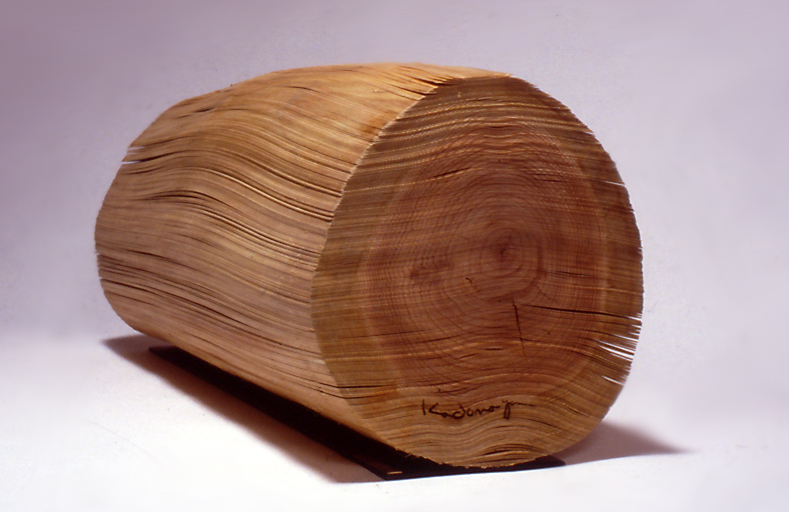| Kadonaga transforms wood and glass into meditations on life and death Seattle Post-Intelligencer Art Review By Regina Hackett, Friday, January 17, 2003 |
 |
| Kazuo Kadonagafs gWood No. 5 F, from 1978, and other Large-scale log sculptures are on display at the Suyama Space gallery. |
Now in his mid-50s, Kadonaga became an artist anyway, and he did it without fatally offending his nearest and dearest. Instead, he convinced them that his version of art and their version of business were different parts of the same enterprise. As a sculptor working with wood, he, like them, transformed the family's raw material into finished product.
The transformation of raw material has been his theme ever since, not just wood but silk and glass. Unlike his family, he's not interested in what he can turn raw material into, but what it can be if he allows it to react to certain intrusions. He wants to help it transform itself. When it comes to lumber, he's more like a beetle than a baron.
In Seattle, Kadonaga is showing in two places. His massive and ungainly piles of glass are at the Greg Kucera Gallery, along with a number of his smaller, sliced log pieces.
| Kazuo Kadonaga : Pure Form Where : Greg Kucera Gallery, 212 Third Ave. S.; Suyama Space, 2324 Second Ave. When : Through Feb. 1 at Kucera Gallery; through April 11 at Suyama Space. Kucera hours: Tuesdays-Saturdays, 10:30 a.m.-5:30 p.m.; Suyama hours: Mondays-Fridays, 9 a.m.-5 p.m. |
First the glass. Seattle has glass coming out its ears. More major glass sculptors live here than anywhere else in the country. It's safe to say, however, that our glass and Kadonaga's share little common ground.
Seattle glass tends to have a Venetian base, with high craft values, devotion to the decorative and a silky sense of its own perfection. Kadonaga's has no craft values and no interest in the decorative. As far as perfection goes, it can't be bothered. For Kadonaga, perfection is a case of arrested development, an attempt to remove art from the real-world realm of living and dying.
Kadonaga likes glass hot, when it's streaming out of a furnace like liquid light and curling up on itself into a kiln, becoming coiled mounds untouched by human hands. At 1,500 pounds each, they take 48 hours to form and another 100 days to harden. In the end, they look as if they poured themselves out, slowly, on the floor. They look like organic excreta, glass in the form of elephant dung.
Death is the mother of beauty, wrote Wallace Stevens. Kadonaga agrees with him. Neither artist is interested in endless delights, in ripe fruit that never fall from the tree. Light fractures through these mounds, which will, over time, crack under their own weight. Although not likely to happen soon, the promise of dissolution is there, and that promise is vital to what the artist wants to attain.
What he has recently achieved in glass, he has been achieving in wood for decades. Growing up around trees, he learned as an artist not to take them for granted. He looks at a log the way a reader examines the outside of a prized book, thinking about its contents.
Just as a reader would be startled were she able to see the sentences inside as the book lay closed in her hand, viewers are startled by their ability to "read" Kadonaga's trees. By slicing and cutting, he brings the inside out without losing the original form.
One log lying toward the center of Suyama Space appears to be cut but not in a radical way. It's intact, more or less. The coherence of the outer form turns out to be a powerful illusion. Seen closely, the log at one end is a wrap of sheets as thin as paper. The cuts thicken and curve into larger pieces at the other end.
Kadonaga hacks into other logs, the force of the blow gouging wounds that reverberate into splinters. The big cracks and the small, irregular seams are a record of the artist's encounter with his material.
I love his massive, pulped paper books. His paper remembers its roots. It's still part of a tree. Turning its pages would be like walking through a small, private forest.
* * * * *